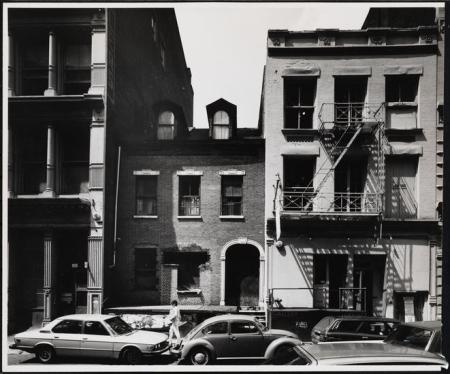With its boarded-up parlor windows, wispy lace curtains, and lone light coming from the attic dormer windows, the 1824 Federal-style house at 139 Greene Street certainly gives off a spooky vibe.
Number 139 has an interesting history as a family home, brothel, factory, and longstanding renovation project. If any house in Soho is haunted by ghosts, this would be the one.
 It all started in 1825, when the home was built by a merchant tailor named Anthony Arnoux, who ran a shop on Broadway and East Fourth Street.
It all started in 1825, when the home was built by a merchant tailor named Anthony Arnoux, who ran a shop on Broadway and East Fourth Street.
In the 1820s and 1830s, Federal houses were all the rage, and the newly fashionable streets north of Canal Street on the west and east sides of Broadway were lined with similar residences built by the city’s elite.
Arnoux didn’t move in until the 1830s, but he and his five adult children (plus one female servant) occupied what must have been a lovely house at least through 1850, according to census data.
 Some of that loveliness remains: the arched dormer windows, red brick, marble stairs, and elegant front entrance.
Some of that loveliness remains: the arched dormer windows, red brick, marble stairs, and elegant front entrance.
The similar yet beautifully restored Merchant’s House Museum, across Broadway on East Fourth Street, is a Federal-style house that gives an idea of what the Arnoux house looked like in its prime.
As Greene Street became shabby, the Arnoux family didn’t stick around. By 1860, the neighborhood had become a bustling strip of hotels, shops, and brothels—lots of brothels.
Number 139 became a house of assignation, according to the Gentleman’s Companion, a guide to New York City’s premier red-light district in 1870.
Greene Street “has become a complete sink of iniquity,” the guide states, with 41 brothels luring in men between Canal and Bleecker Streets.
 139 Greene Street was a third-class “disorderly house” with 7 “inmates” run by Patrick and Amelia Whalen. A fire broke out there in 1867, reported the New York Times.
139 Greene Street was a third-class “disorderly house” with 7 “inmates” run by Patrick and Amelia Whalen. A fire broke out there in 1867, reported the New York Times.
After the prostitutes left, the millinery trade moved in, followed by light industry.
Perhaps the manufacturer of printers rollers (as advertised on the facade of the cast-iron loft building next door) had something to do with the bashing in of the front wall of the house, as well as the destruction of the marble front stairs.
In 1968, with Soho’s fortunes rising, an art dealer bought it to use as a storage space, then sold it to an art conservationist—who has been restoring 139 Greene Street ever since . . . and perhaps allowing its 19th century ghosts free reign to haunt the premises.
[Third image: New York Times; fifth image: MCNY; 1970s]



